ADDRESS AT THE SYMPOSIUM ON LAUNCH VEHICLES: PAST, PRESENT AND WAY AHEAD AT VSSC, THIRUVANANTHAPURAM
28-07-2005 : Thiruvananthapuram
VISION FOR SPACE MISSIONS(2005-2030)
I am indeed delighted to participate in the symposium on Launch Vehicles: Past, Present and Way Ahead on the occasion of the Silver Jubilee celebrations of the first successful launch of SLV-3. It was a great day 25 years before that India became an exclusive member of the Space Club when SLV-3 E02 placed the Rohini Satellite in the near earth orbit. ISRO has come a long way today heralding self reliance in space technology with capability to design and develop any type of launch vehicle and spacecraft. All of you assembled here and many others have contributed for making India a Space Power. I greet all of you for participating in this great event. On this occasion we remember the pioneering contributions of Dr. Vikram Sarabhai, Prof. Satish Dhawan, Dr. Brahmprakash, Shri MR Kurup and Dr. S Srinivasan.
I was asking myself, what thoughts I can share with such important space community. I know the dream of the people of India. I am also aware about their pain and sorrow. We are one sixth of the world's population and at least two thirds of the global population is perhaps going through the same type of crisis and turmoil. Energy, water, healthcare, education and employment potential are the important requirements for the people to live with prosperity. The world at large needs technology inputs for meeting these needs. Space technology has a role. Therefore, I am going to discuss with you the Vision for Space Missions to find solution to these requirements using space technology.
Aerospace Systems in India
India?s space, missiles and aeronautics programmes in the last four decades have led to successful missions and accomplishments. India is toady self-reliant in space technology. It has evolved operational PSLV and GSLV which could provide competitive launch services. In the missile programme, India has operational strategic systems using critical technologies developed by indigenous efforts with multiple institutions partnership. The recent break-through has been BRAHMOS ? a supersonic cruise missile, the best of its kind in the world attracting large-scale exports. Advanced Light Helicopter, Light Combat Aircraft, SARAS, IJT and Advanced Remotely Piloted Vehicles have established the aircraft design capability. Most of them are in production and marketing phase.
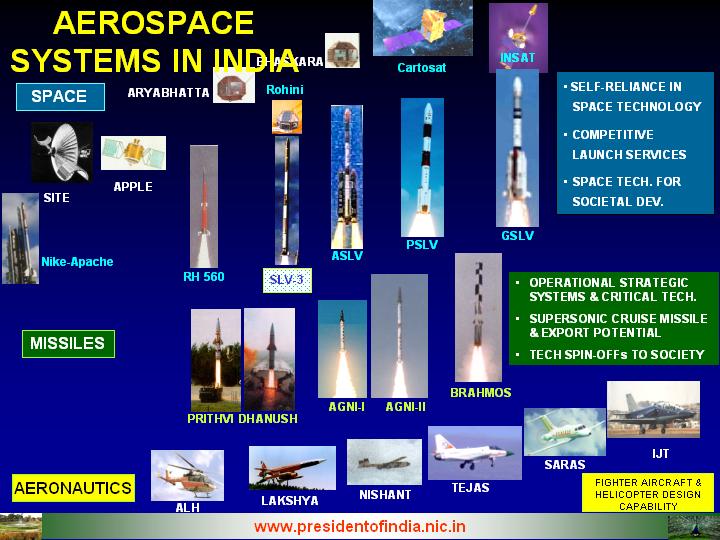
The vision of Dr. Sarabhai and Prof. Satish Dhawan with two space profiles 1970-80 and 1980-1995 respectively were the blue prints and today those visions have become reality. With those space profiles of our visionary leaders and with the integrated technology strength of the nation, we can march further to envision new missions. Let us see the glimpses of space technology benefits.

Satellite remote sensing
Satellite remote sensing is vital for mapping of different ground resources like water, minerals, agriculture, urban planning, coastal regions, forestry, engineering geology and mineral exploration. Regional research centers in the many states / regions of our country and the multiple villages are utilizing the data coming from the satellite. This large potential must be effectively used.
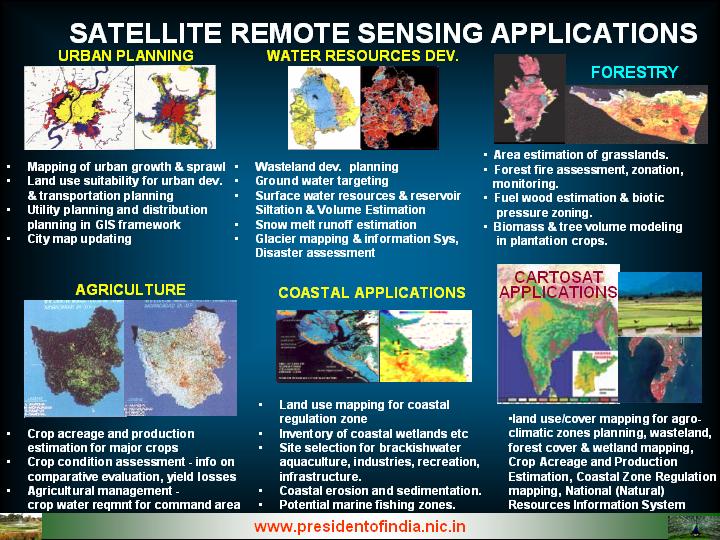

Disaster Management
In many places in our planet, we experience severe disasters like earthquakes, tsunami, cyclone resulting in loss of life, loss of wealth and in some cases it destroys the decades of progress made by the country and its valuable civilizational heritage. India has earthquake problems periodically in certain regions. US, Japan, Turkey, Iran and many other countries also suffer due to earthquakes.
Earthquake/tsunami is a sub terrain phenomenon and predicting this from space observations would be a great challenge. Space scientists of multiple nations should work with determination to use satellite deep penetration images to predict the earthquake or shock wave propagation. Other possibilities are precise geodynamic measurement of strain accumulation by satellite to detect pre-slip, and electromagnetic phenomena prior to final rupture.
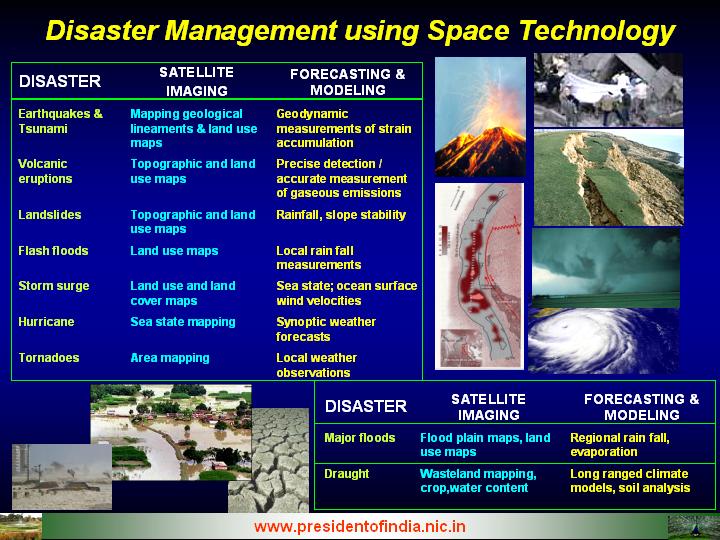
It is hoped that well organized electromagnetic monitoring may provide unique observational information on the pre-slips. Atmospheric/ionospheric anomalies still remains unresolved. Post earthquake disaster recovery, communication and damage assessment are also areas where space technology can quickly make its impact. We have to mount research programmes for evolving a systematic methodology for determining the effects leading to earthquakes and tsunami. Space technology can be used for forecasting and modeling of volcanic eruptions, land slides, avalanche, flash floods, storm surge, hurricane and tornadoes. We should also integrate the various efforts with the National Authority for Disaster Management.

Communication network
Satellite Communication network has helped India in providing education and health care in the form of Tele-Education and Tele-medicine. The prime objective of the EDUSAT programme is to provide support to education through low-cost ground segments and to reach the un-reached people of India to every nook and corner. EDUSAT is specially configured to have multiple beams covering different regions of India. EDUSAT provides communication coverage through five regional beams and a national beam. This system will be primarily for school, college and higher level of education; however it will also support non-formal education. EDUSAT is expected to provide one-lakh fifty thousand ground terminals in its full capacity.
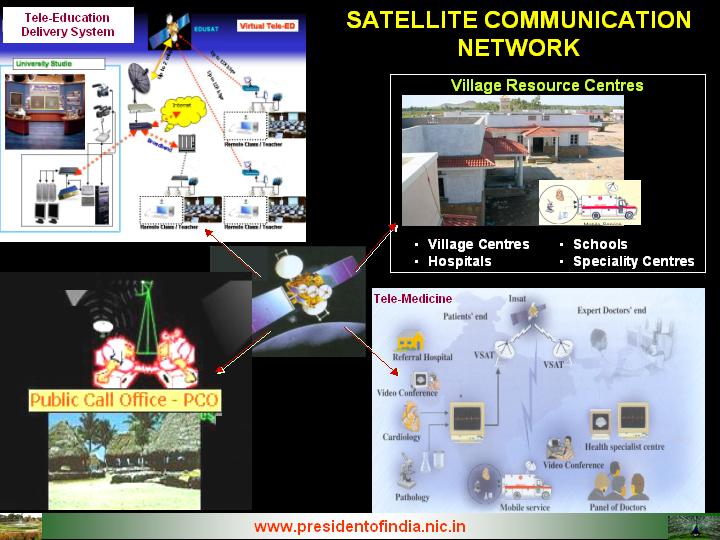
Like Tele-education, Tele-medicine can help in a big way in bringing modern health care treatment within the reach of remote villages. I am happy to know that ISRO has used satellite network to connect remote villages to major hospitals wherein a patient?s condition is diagnosed by a specialist doctor and his views communicated through the communication links.
These links would be the window to the world of knowledge for our villages and also to reap the benefits of our e-governance, tele-education, tele-medicine, e-commerce and e-judiciary initiatives. I visualize establishment of village knowledge centers in all Panchayats to empower the villagers with the knowledge and to act as a nodal center for knowledge connectivity for the villagers. The knowledge center will provide to the villagers the real time information about the market details on their products from the agriculture, cottage industry, fisheries and other rural industries in their locality as well as national markets. This also will provide direct quality employment to over one million people who will be instrumental in promoting higher level of wealth generation in our rural sector.
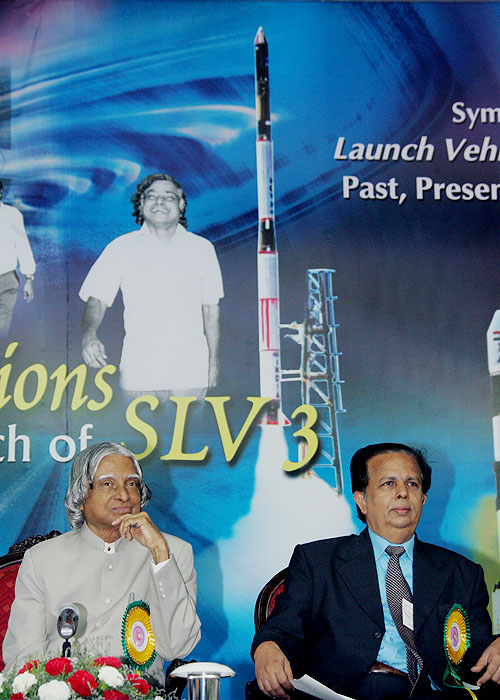

Aerospace Technology Strength
Due to various aerospace programmes, multiple state-of-the-art technologies got developed. Computational Fluid Dynamics (CFD) emerged as core strength for India with advanced software codes and super computing capability to optimize configurations for guided missiles, LCA and launch vehicles. CAD / CAM has become the order of the day for Aerospace systems and virtual reality systems have been developed which reduces the design and product realization time by as much as 40%. India has developed fibre optic and ring laser gyros with better accuracies, micro processors, microwave components and devices, phase shifters, onboard computers and foundries for making VLSI and MMIC components have also been set up thus making India self dependent. In the area of propulsion, ISRO?s large solid propulsion booster giving 500 tonnes of thrust, liquid propulsion in DRDO and ISRO, and the development effort of Cryogenic engines, established a sound base in propulsion technology.
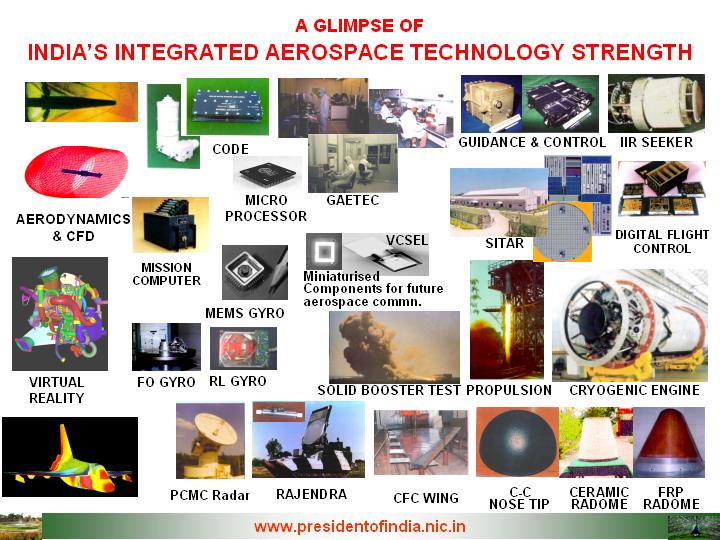

Emerging Aerospace Technologies
Emerging technologies such as MEMS, Nano, Information technology, biotechnology, space research, Hypersonics and High power lasers and microwave will be dominating the future in every field and applications. The advancements in material science and technology will give a major thrust to the realization of advanced aerospace systems. We are today at the convergence of Nano, Bio and Information technologies, that will lead to new generation aero space devices and products.
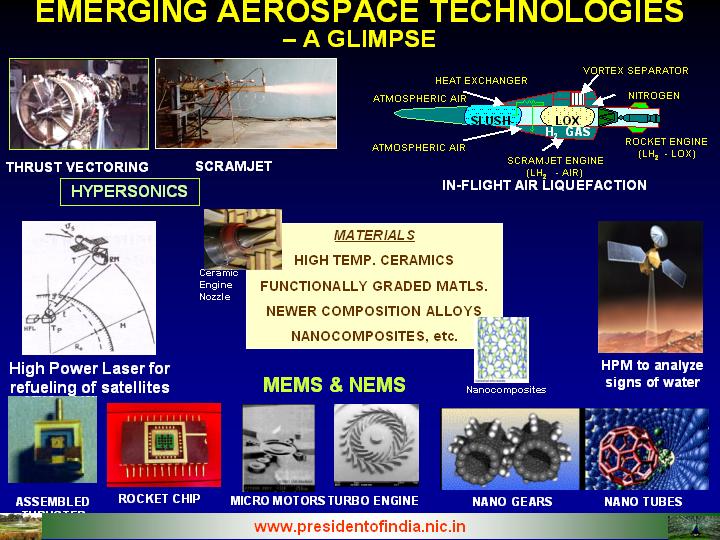

MEMS & Nanotechnology
The advances in the fields of micro-electromechanical systems (MEMS) and nanotechnology have paved the way to the evolution in the ability to manufacture smaller and smarter products. MEMS bring together microelectronics with micromachining technology, allowing unprecedented levels of functionality and reliability to be placed on a small silicon chip. Nanotechnology, on the other hand, is the science of assembling atoms and molecules that respond to stimuli, with dimensions on the order of a nanometer (one in billion of a meter).
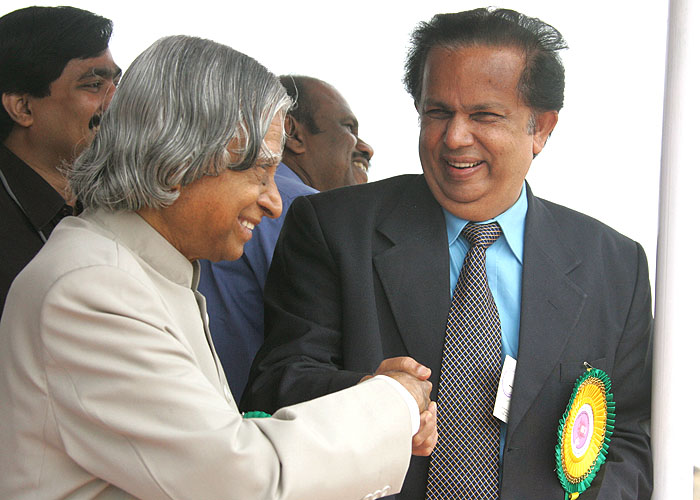

MEMS Devices for aerospace application
Micro Electro Mechanical Systems (MEMS) technology will have a profound impact in the aerospace field with the miniaturization of electronics. These tiny machines, often only a few micrometers in size, are already replacing conventional larger equipment. Given their microscopic size and weight, MEMS can use higher frequency and bandwidths and can be slipped into tighter and even more environmentally stressed locations. Once in production, unit prices are lower; once in operation, power consumption is negligible. Examples of which are pressure sensors, fluid flow sensors, magnetic sensors, gyros, accelerometers & more. MEMS is also expected to play a significant role in dramatically reducing the cost of space exploration with substantial savings in weight and increased reliability and functionality. Eventually, MEMS could lead to the development of extremely low cost micro satellites.
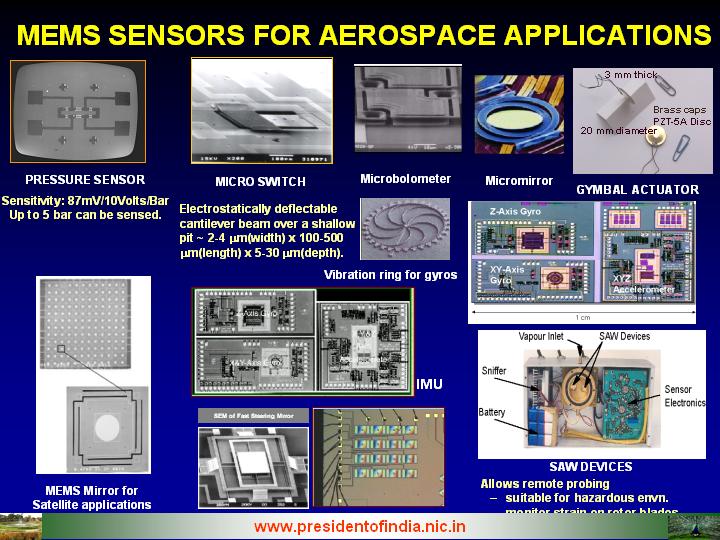

Nano Technology
Molecular nano technology has enormous potential for future aerospace systems. Research has shown that newly discovered class of molecules, particularly carbon nano tubes built from graphite sheets curved into a wide variety of close shapes, may lead to tougher, high temperature materials that can survive in vacuum and other harsh environments. Carbon nano tubes are normal form of carbon with remarkable electrical and mechanical properties. It is hoped that such materials could revolutionize electronic design and open the space frontier by radically lowering the cost of launch to orbit.
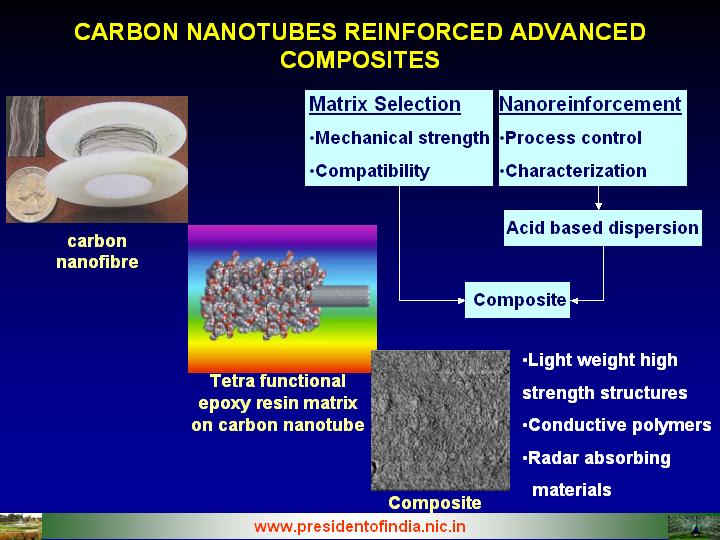
Carbon Nano tubes reinforced with polymer matrix will result in compo-sites which are super strong, light weight, small and intelligent structures in the field of material science. This has tremendous aerospace applications.
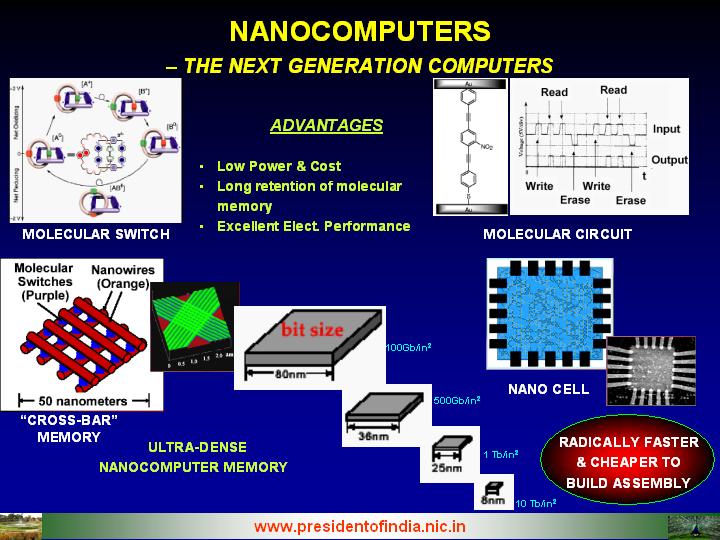
Molecular switches and circuits along with nano cell will pave the way for the next generation computers. Ultra dense computer memory coupled with excellent electrical performance will result in low power, low cost, nano size and yet faster assemblies.

Triad of Nano-Bio-Info Technologies
With the emergence of Nanotechnology, there is convergence of nano bio info technologies resulting new devices which has wider applications in structure, electronics, healthcare and space systems.
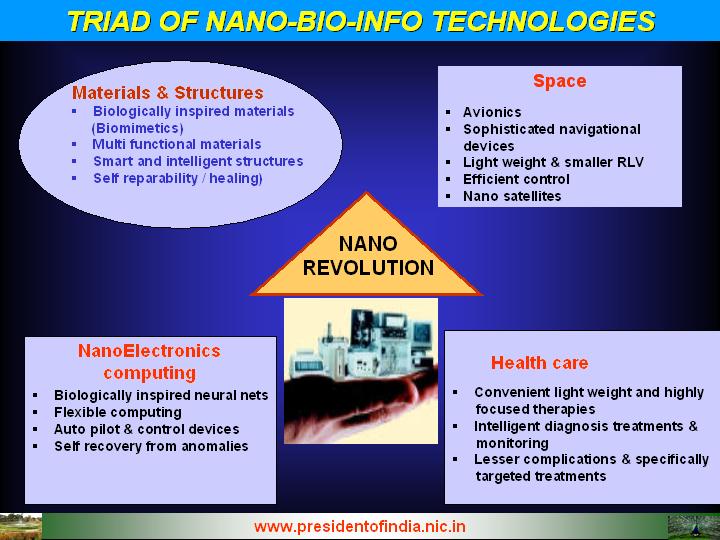

Energy for future generations
The era of wood and bio-mass is almost nearing its end. So to the age of oil and natural gas would soon be over even within the next few decades. The world energy forum has predicted that fossil based oil, coal and gas reserves will last to another 5 ? 10 decades.
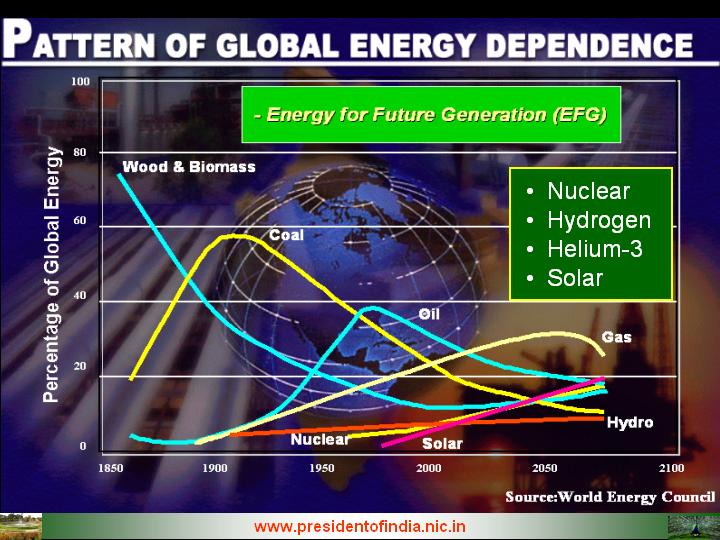
Nuclear power especially a breakthrough in nuclear fusion may be a path. Concerted effort is called for the conversion of Thorium fuel to enriched Uranium for nuclear power is a must for self-reliance. Hydrogen fuel and solar rays are the two modes to get clean power. The solar rays, when passed though CNT based solar photovoltaic cells utilizing nano-rods will give efficiency of more than 50% from the present efficiency of less than 20%. Hydrogen in combination with fuel cell can replace fossil fuels used in automobile. Hydrogen - a zero emission fuel facilitating pollution control & the process is regenerative. CNT multi-walled structures can store the Hydrogen for power generation.
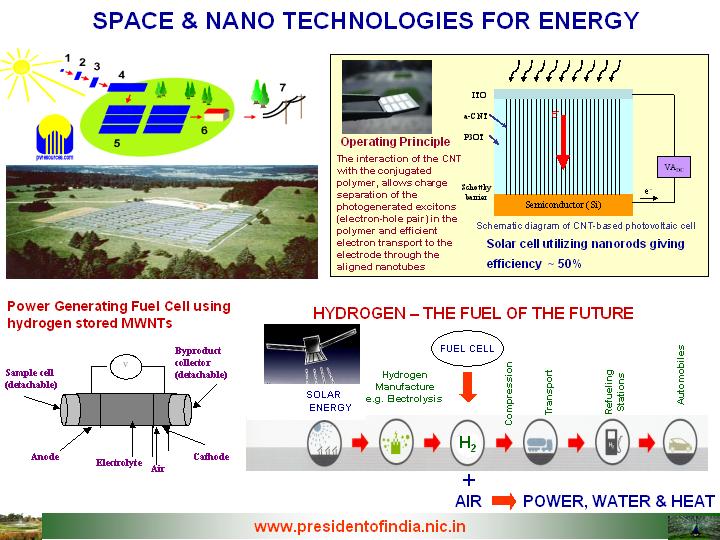

Water for future generations
More than 70% of earth surface is having water; but only one percent is available as fresh water for drinking purposes. Currently, more than half of the world's six billion population is without access to safe drinking water and sanitation. Twenty thousand children are affected every day due to polluted drinking water, more than the total mortality due to cancer, AIDS, wars and accidents. By the year 2030 when the world population touches eight billion, as many as seven billion will be living under conditions moderate, high and extreme water scarcity. There is a four-fold method towards providing safe and fresh drinking water. The first is to re-distribute water supply; the second is to seek new sources; the third is to save and reduce demand for water; and the fourth is to recycle used water supplies.
In the programme of networking of rivers, remote sensing satellites can survey and evolve optimum water routes, environmental mapping and aforestation requirements, and continuous monitoring of the networked water flow through all seasons. This may require a dedicated satellite for our networked river systems.
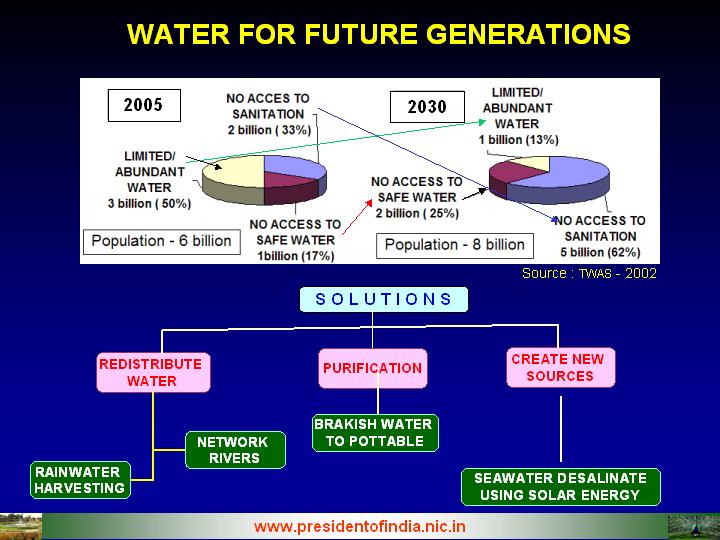
Remote sensing satellites can provide the images showing the locations of the watersheds. From these watersheds, fresh water can be generated employing CNT based membrane through reverse osmosis process. Another method of using space for solving the water crisis can be the use of solar power satellites. Energy obtained from such satellites can be stored in high energy CNT solar cells which provide the power to desalination plants for large-scale drinking water supplies in coastal cities.
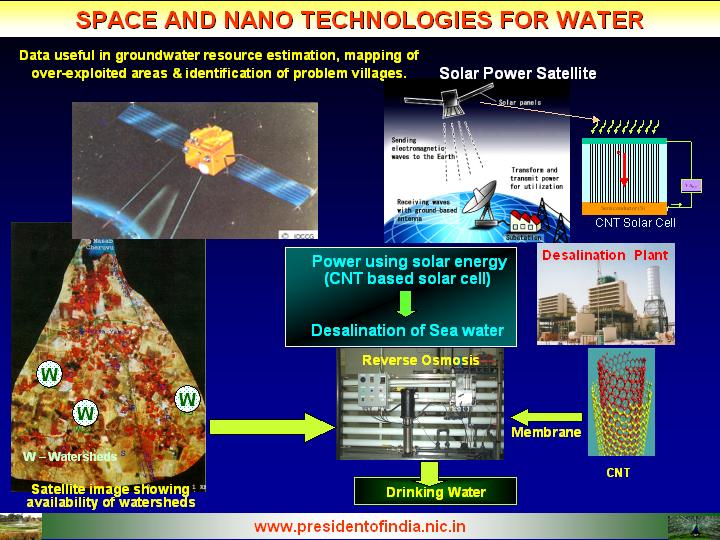

Space Industrial revolution
Having missed the opportunity of the first industrial revolution, India is still a developing country. Now the developed countries are racing towards moon and mars which may be the next industrial revolution. India has the opportunity now to join this exclusive club of nations to establish industry in moon and mars. The technological challenges are:
- Manufacturing and Mining in reduced gravity.
- Harnessing Helium-3 in moon for future energy, using oncoming fusion technologies.
- Using dry ice deposits in moon and mars as source of fuel rocket engine.
- Extending life of satellites in orbit through refueling and repairing.
- Using the Moon as space transportation hub.
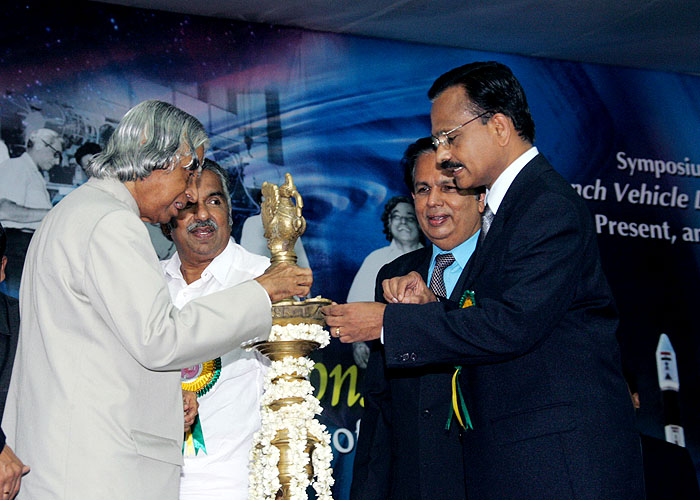

Cost of access to Space
As the space missions are increasing with larger payloads, it is essential to reduce the cost of access to space by several orders of magnitude. Such a reduction can enable the global space community to move out of the present era of information collection missions into an era of mass movement missions. They can find solutions for energy, water and mineral crisis. Mankind will continue to live on earth for many billion years. We need good life for our generations. Therefore, it is necessary to bring resources the earth needs from other planets.
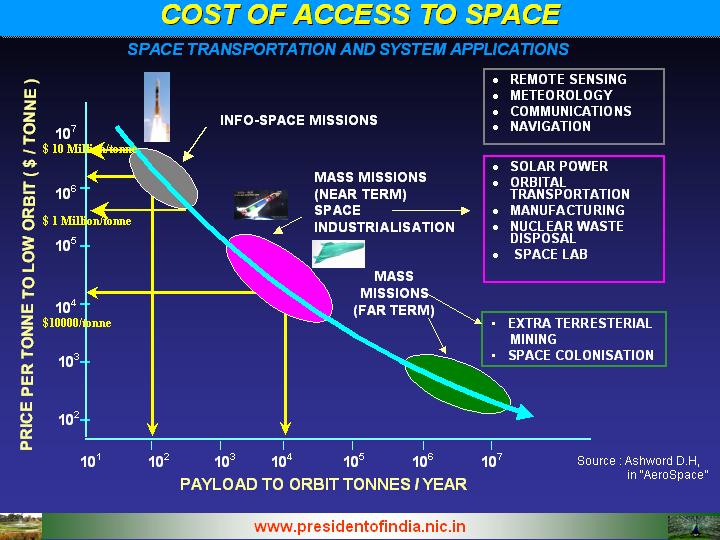

Cost reduction strategies
Integrated aerospace technology strength in multiple S&T organizations would lead to better capacity utilization, and the creation of low cost space transportation. We have to evolve innovative design concepts for both small as well as large payloads into space. Both single and two-stage to orbit RLV concepts can be examined. The goal here is to reduce the cost of access to space by one to two orders of magnitude. Even a scientific breakthrough, for example, in air breathing propulsion system may lead to a Space Transportation revolution. The world Space community has a huge stake in such breakthrough research in advanced inter-disciplinary and inter-institutional collaboration. A concerted effort is thus needed to quickly demonstrate the technology for low cost access to Space. ISRO take the lead in bringing the space community together.
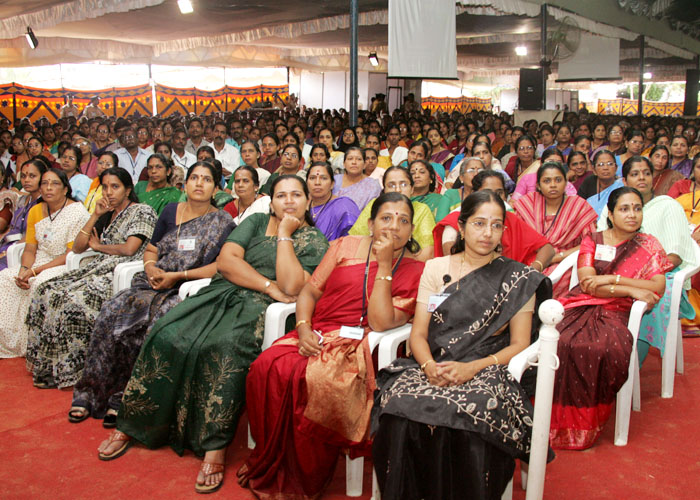

Reusable Aerospace Vehicles
The global space industry has had a forty-year period of unprecedented growth and prosperity. The geo-stationary orbit is nearly full, and new earth orbits need study and exploration, especially use of small satellites in equatorial low earth orbit. Currently, global space industry has a capacity to launch over 200 tonnes of satellites every year. However, the forecast is that projected demand will consume less than half of this established capacity. Thus a bitter price war is on to capture this limited market.
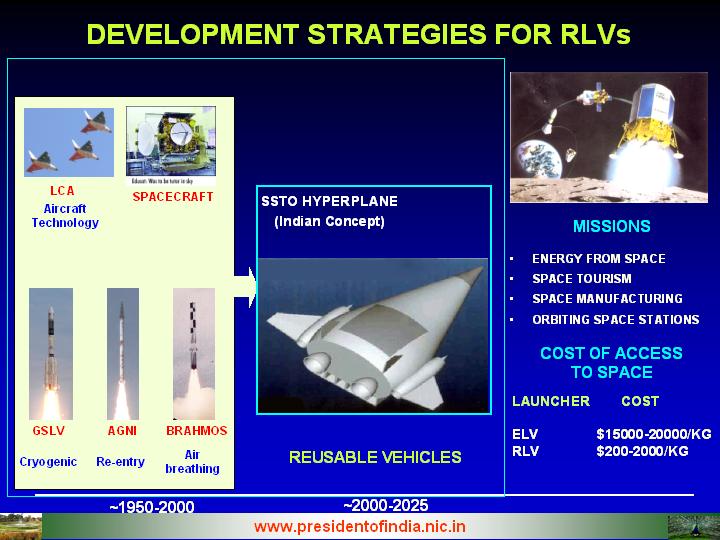
The Indian concept of Hyperplane, a fully reusable system is an innovation in rocketry providing a payload fraction of 15%, drastically reducing the launch cost. The concept of mass addition in space has been worldwide appreciated and a few countries have started working on the heat exchanger for on-board generation of liquid oxygen. There is an urgent need to progress the cost effective SSTO hypersonic plane in our country.
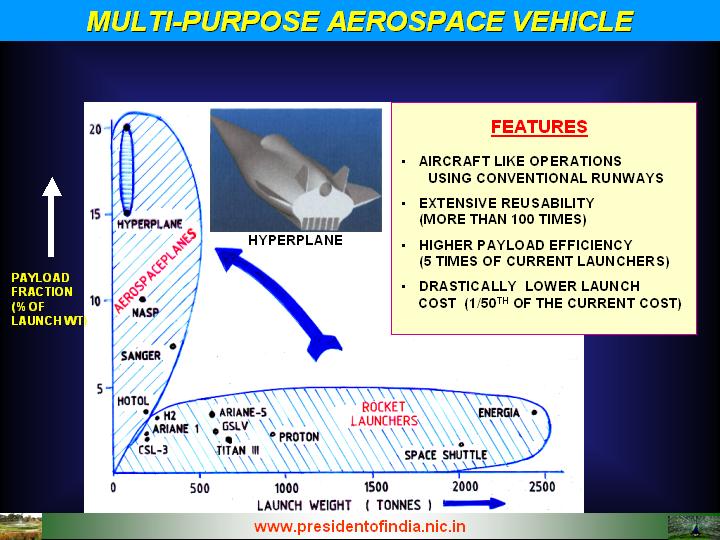

Aerospace system applications - a perspective
With the growing space efforts, the coming years will have a dominance of reusable launch vehicle. They will provide cost effective transportation of heavy payloads in order to construct large structure in space. The future needs will be solar power satellites for generation of electric power, exploration of planets, mining in moon and mars and space habitats.
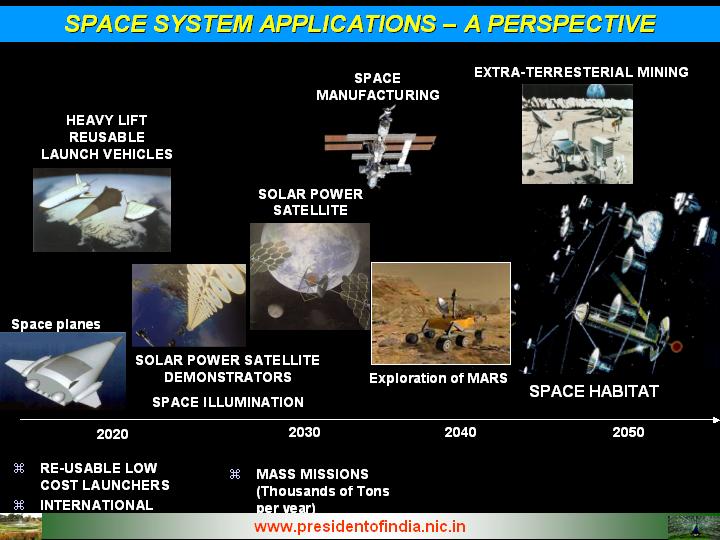

Space Missions (2005 - 2030)
In the last 25 years, Indian Space, Missile and Aircraft technologies have matured and have tremendous integrated potential for developing world class newer systems. While we are celebrating this silver jubilee, we must look forward to missions for the next 25 years. Therefore, I suggest the following space missions:
1. Manned Space Missions to Moon & MARS and establishment of space industry.
2. Cost effective space transportation systems using Hypersonic Reusable Vehicles (SSTO)
3. Harnessing Space energy for power & drinking water
4. Developing Solar Sail for inter planetary mission
5. Integrated Disaster Management ? Role of space technology
6. Refueling, Repair & Maintenance of Satellites in Geo Orbit
7. Operational Indian Navigational Satellites
8. International ?Youth Power? connectivity
satellite.
Future space missions throw upon new opportunities and challenges to the scientific community and the youth of India. Use this opportunity to make the nation great.
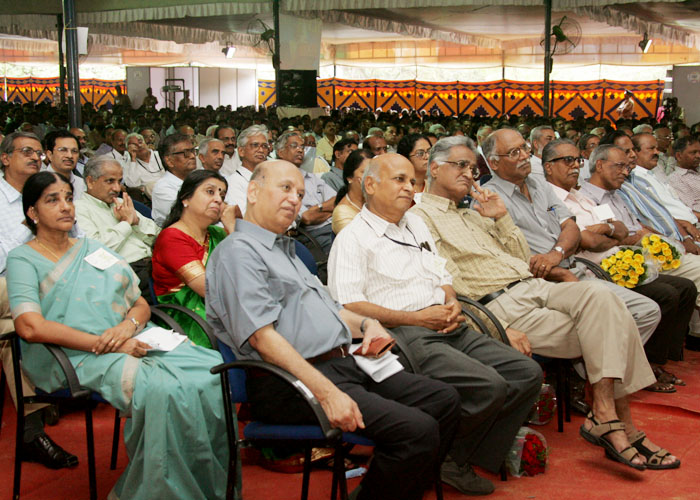

Conclusion
Thinking beyond our planet is an essential trait. The thought itself elevates the person. The person is transformed into a creative state. Creativity indeed is the foundation of discovery and inventions.
I recall the great saying of the Saint Maharishi Pathanjali in Yoga Sutra at 500 BC:
"When you are inspired by some great purpose, some extraordinary project, all your thoughts break their bounds. Your mind transcends limitations, your consciousness expands in every direction, and you find yourself in a new, great and wonderful world. Dormant forces, faculties and talents come alive, and you discover yourself to be a greater person by far than you ever dreamt yourself to be."
Space have to become another place. This calls for cost effective and reliable space transportation and manned missions.
May God Bless you.
<<Back
|